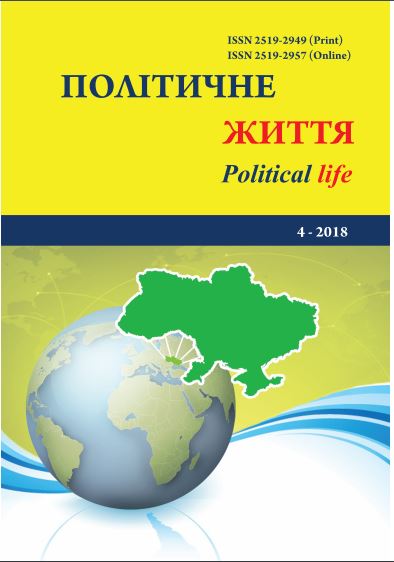Problem of correlation of the doctrine R2P and preventive humanitarian intervention.
DOI:
https://doi.org/10.31558/2519-2949.2018.4.20Keywords:
the doctrine of “Responsibility to Protect” (R2P), preventive humanitarian interventionAbstract
This article has an object to descript the problem of doctrine R2P and preventive humanitarian intervention. The multinational military operation in Libya in 2011 was the first operation conducted in accordance with the doctrine of “Responsibility to Protect” (R2P). The Libyan operation became the first major test of the very tool of R2P policy (preventive humanitarian intervention); the operation has acquired a large military intervention to protect civilians from the threat of mass murders. Disputes over the mission in Libya continue to hamper the discussion of new such missions. A careful analysis of the concept provides an understanding of whether the use of R2P and preventive humanitarian intervention is possible under the current conditions of a global transformation of international relations. In the last two decades a lot of research has been conducted, but the ethical aspect of using armed force for preventive purposes as well as the question of the possibility of the existence of the R2P doctrine without the use of preventive humanitarian intervention requires further exploration. Therefore the purpose of the article is to analyze the main problems associated with the lack of understanding of the doctrine and the tools for implementing R2P, which has generated negative assessments of its use in practice. The problems inherent in the concept of preventive humanitarian intervention can not be fully resolved. They are and remain the attributes of this type of military operation and the very doctrine of R2P. But doctrine continues to enjoy international support as a set of general principles. This doctrine also covers non-military elements from observing human rights to various types of international assistance aimed at reducing the risk of mass atrocities. The problems are primarily due to the “war pillar” of R2P: prone to illegality, human and financial costs, the extension of the mandate, and hypocrisy. Each of these problems is complicated in itself, and their interaction intensifies each other. As a result any attempts to use the compulsory tools of the R2P doctrine are doomed to a poor result both for the interventionists and for the doctrine itself.References
Jentleson B. The Obama Administration and R2P: Progress, Problems and Prospects / B. Jentleson // Global Responsibility to Protect. – 2012. – Vol. 4, N 4. – P. 399–423.
Paris R. The ‘Responsibility to Protect’ and the Structural Problems of Preventive Humanitarian Intervention / R. Paris // International Peacekeeping. – 2014. – Vol. 21, N 5. – P. 569–603.
Tardy Th. The Dangerous Liaisons of the Responsibility to Protect and the Protection of Civilians in Peacekeeping Operations / Th. Tardy // Global Responsibility to Protect. – 2012. – Vol. 4, N 4. – P. 424–448.
Williams P. D. Principles, Politics, and Prudence: Libya, the Responsibility to Protect, and the Use of Military Force / Williams P. D. and A. J. Bellamy // Global Governance. – 2012. – Vol. 18, N 3. – P. 270–285.
Roberts A. NATO’s Humanitarian War over Kosovo / A. Roberts // Survival. – 1999. – Vol. 41, N 3. – P. 110–124.
Mills K. From Humanitarian Intervention to the Responsibility to Protect / K. Mills and C. O’Driscoll // The International Studies Encyclopedia. – London: Wiley-Blackwell, 2010. – P. 2532– 2552.
UN Security Council Resolution 1973, March 17, 2011, para 4.
UN General Assembly, 2005 World Summit Outcome, UN doc., A/60/L.1, September 15, 2005, paras 138–139.
Evans G. Responsibility While Protecting / G. Evans // Project Syndicate, January 27, 2012. [Електронний ресурс]. – Режим доступу: www.projectsyndicate.org/commentary/responsibility-while-protecting
Thakur R. UN Breathes New Life into “Responsibility to Protect” / R. Thakur // Toronto Star, March 21, 2011. [Електронний ресурс]. – Режим доступу: www.thestar.com/оpinion/editorialopinion/2011/03/21/ un_breathes_life_intoresponsibility_to_protect.html
UN Department of Public Information, Secretary-General Tells Conference, Stressing Need to Prevent Conflict Before It Breaks Out, UN doc., SG/SM/12063, January 19, 2009.
Orchard Ph. The Evolution of the Responsibility to Protect: At a Crossroads? / Ph. Orchard // International Affairs. – 2012. – Vol. 88, N 2. – P. 377–386.
Pape R. When Duty Calls: A Pragmatic Standard of Humanitarian Intervention / R. Pape // International Security. – 2012. – Vol. 37, N 1. – P. 41–80.
Binder M. Humanitarian Crises and the International Politics of Selectivity/ M. Binder // Human Rights Review. – 2009. – Vol. 10, N 3. – P. 327–345.
Brown S. An Evolving Hope That’s Here to Stay / S. Brown and R. Neumann // The American Interest, June 12, 2013. [Електронний ресурс]. – Режим доступу: www.the-american-interest.com/articles/2013/06/12/anevolvinghope-thats-here-to-stay
Byman D. Humanitarian Intervention and Communal Civil Wars: Problems and Alternative Approaches / D. Byman and T. Seybolt // Security Studies. – 2003. – Vol. 13, N 1. – P. 33–78.
Bellamy A. The Responsibilities of Victory: Jus Post Bellum and the Just War / A. Bellamy // Review of International Studies. – 2008. – Vol. 34, N 4. – P. 601–625.
Benner Th. Brazil as a Norm Entrepreneur: The “Responsibility While Protecting” Initiative / Th. Benner // Working Paper, GPPi, Berlin, March 2013.
Giffen A. Addressing the Doctrinal Deficit: Developing Guidance to Prevent and Respond to Widespread or Systematic Attacks Against Civilians / A. Giffen // Workshop Report, Washington, DC: Stimson Centre, spring 2010.

